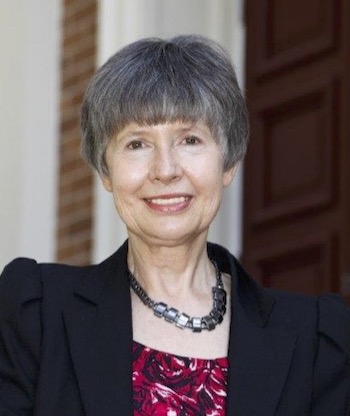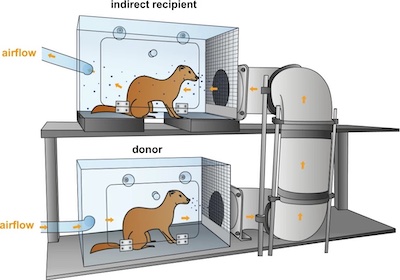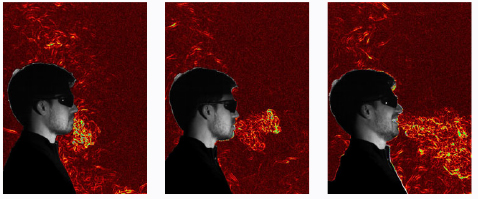
A breath of fresh air
There would be a scandal if thousands of people were dying from a disease caught from the water that comes out of the tap. Or if commonly used building materials were causing widespread disease. Could the COVID-19 pandemic change our expectations about catching diseases from the air indoors?

Lidia Morawska
Regulating for, even expecting, clean indoor air might seem impossible. But we already have air quality regulations for things like exposure to CO2, says Lidia Morawska, an aerosol physicist and co-chair of the WHO Air Quality Guidelines group. Morawska spoke at a science meeting hosted by the Newton Gateway to Mathematics as part of the RAMP Continuity Network (you can watch her talk here).
Limiting the impact of airborne disease is more difficult, but we can use the knowledge we already have to develop advanced guidelines for the design of buildings and their ventilation systems. "We need to change the perception that we cannot afford to do this. In fact the economic costs [of not doing this] are much bigger than any other costs."
COVID-19 is airborne
Initially in the pandemic there was some confusion about how the virus causing COVID-19 was transmitted. Indeed in March 2020 the the World Health Organisation (WHO) tweeted that COVID-19 wasn't airborne. "It is airborne," says Morawska, who played a pivotal role in convincing the WHO and other organisations that COVID-19 was transmitted by the air we breathe. And there is growing evidence that airborne transmission is responsible for the majority of infections of COVID-19.

Catherine Noakes
One explanation for the initial confusion is that airborne transmission of a disease is tricky to explicitly measure. "It's hard to sample from the air," says Catherine Noakes, a fluid dynamicist who has played a leading role in the UK efforts to deal with COVID-19 as a member of SAGE (the Scientific Advisory Group for Emergencies). Noakes spoke at the science meeting about how COVID-19 is transmitted and what uncertainties are involved (you can watch her talk here).
"You will only find [the virus in the air] if an infected person was present very recently. You won't find it if the person was there, say, five days earlier." Rather than using direct measurements, we need to rely on understanding the physics of aerosols (small particles that can remain suspended in the air for some time) and the biology of ourselves and the virus, to understand airborne transmission of COVID-19.
The most direct evidence of airborne transmission is from laboratory studies, such as those involving ferrets and hamsters. These have shown that both transmission from close contact and infected surfaces, and airborne transmission are possible in these animal experiments. "But there are limits to what [these] cases tell us," says Noakes. "Hamsters are not people and they don't cough or blow their noses."

One of the experimental setups used to show that airborne transmission of COVID-19 is possible, for ferrets, who do not blow their noses. (Image from Kutter et. al. 2021 – CC BY 4.0)
We now have a substantial and growing body of evidence from the pandemic itself. What such data has shown is that close interactions, in smaller spaces and with multiple opportunities and routes for transmission, increase the risks of passing on an infection.
There is very little evidence for transmission outdoors, apart from close mingling at outdoor parties. "Nearly every [superspreading event] is indoors, many are associated with poor ventilation, and many are associated with singing or aerobic activity," says Noakes.
A clear example of airborne transmission comes from the outbreak from a choir practice in Skagit County, Washington in March 2020. There 61 people rehearsed inside for 2.5 hours, with one choir member infected with COVID-19 with mild symptoms.
Despite there being no physical contact and the members using hand sanitiser, 53 people are thought to have gone on to be infected, and sadly three of these were hospitalised and two died. The people who became infected were dispersed throughout the rehearsal room and the transmission couldn't be explained by close proximity (the disease being transmitted by droplets from the infected person) or touching infected surfaces alone. But mathematical modelling of this outbreak allowing for airborne transmission closely matches the outbreak data.
Many similar studies of other outbreaks show that models assuming airborne transmission are needed to accurately simulate the recorded outbreak data.
"Airborne transmission must be mitigated," says Morawska.
Grasping thin air
An important part of understanding the airborne spread of COVID-19 is understanding exhalation physics. "Exhaled breath is similar to a Gaussian plume," says Noakes. But it is still a challenge to incorporate the variability found in the size and number of virus particles people expel into real-life risk models. There are room scale models of aerosol exposure, such as the Wells-Riley model, but traditionally these assume the air in the room is well mixed. "We need to start incorporating more complex flow physics into these," says Noakes. "A distance of six foot [from an infected person] might be no different to 60 foot in a well mixed model, but it might well be in practice."

The exhalation produced by breathing, talking and laughing without a mask. Image from Effects of ventilation on the indoor spread of COVID-19 by Bhagat, Davies Wykes, Dalziel, and Linden. Journal of Fluid Mechanics, 903, F1.
What is clear from the outbreak data is that good ventilation is a key to limiting airborne transmission of COVID-19. And there are two key aspects to good ventilation: sufficient ventilation, meaning there is enough, and effective ventilation, meaning the air is refreshed everywhere. "Assessing the requirements for sufficient ventilation is possible and we can do it well." There are general solutions to the question of sufficient ventilation given in terms of the outdoor-air exchange or flow supply rate, such as those given by calculating the ventilation rate required to reduce exposure using the Wells-Riley model. "But the assumption is uniform mixing of the air which is not necessarily the case."
Understanding the airflow in a space is vital in providing effective ventilation. Morawska illustrated this with an outbreak resulting from a particular restaurant in China. "In part of the restaurant the airconditioner was turning the air around the infected person and causing infection in this part of the restaurant. The problem here was the flow direction, as well as the flow supply rate."
Researchers use computational fluid dynamics (CFD) to model the airflow in a space, and this modelling is an important part of analysing outbreaks such as the one in the restaurant (you can read more about CFD here). "CFD modelling will provide the answers for specific indoor spaces, but we need more general solutions," says Morawska. "This is one of the biggest complexities, assessing the requirements for effective ventilation is still very difficult. This generalisation is still not there and that's what we need to work on."
Beyond COVID-19
See here for all our coverage of the COVID-19 pandemic.
Updating our expectations for clean indoor air won't just be useful for tackling this particular disease. "The next pandemic will be caused by a virus of different characteristics," says Morawska. "Whatever resilience we build, it should apply to all types of airborne infection, and in particular to seasonal flu."
The cost of such changes to building regulations and engineering controls might seem high, but the costs of epidemics of respiratory infections that occur every year are higher: they run to sickening millions of people, killing thousands and causing billions of dollars in economic losses.
"In the future we need a paradigm shift for how buildings are designed, how they are equipped and operated, to minimise all air risks, including airborne infection transmission." Morawska thinks it should be feasible to limit the impact of outdoor and indoor pollutants and mould, keep the space a comfortable temperature, as well as limiting our chances of catching diseases from the air.
This article was produced as part of our collaboration with the Isaac Newton Institute for Mathematical Sciences (INI). You can read all our the content produced as part of our collaboration here.
The INI is an international research centre and our neighbour here on the University of Cambridge's maths campus. It attracts leading mathematical scientists from all over the world, and is open to all. Visit www.newton.ac.uk to find out more.
